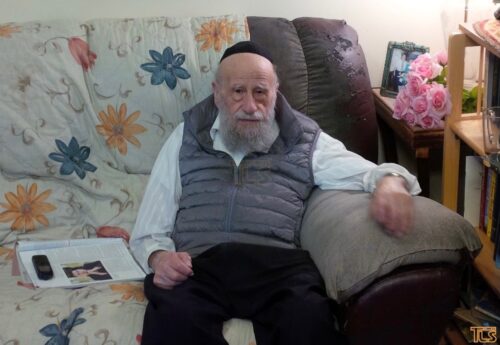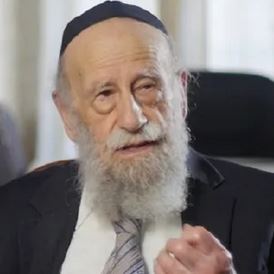 We regret to inform you of the Petirah of Reb Menashe Tzvi Winkler Z”L, a Talmid of the Chofetz Chaim, who was Niftar today in Lakewood. He was 102 years old.
We regret to inform you of the Petirah of Reb Menashe Tzvi Winkler Z”L, a Talmid of the Chofetz Chaim, who was Niftar today in Lakewood. He was 102 years old.
People from around the world would frequently visit Reb Menashe Z”L, who was one of the last remaining people to have the seen the Chofetz Chaim, Reb Baruch Ber, Reb Elchonon and other Gedolim from the previous generation.
The Levaya is scheduled to take place at 4:30 PM at the Lakewood Commons Shul, 44 Coles Way, Lakewood.
Baruch Dayan Hae’emes.
———————————–
 See article below about Reb Menashe Z”L,
See article below about Reb Menashe Z”L,
he Chofetz Chaim, Rav Elchonon Wasserman, Rav Boruch Ber… and the King of Denmark? As the senior-most interviewee that we spoke to for this series, Rabbi Menashe Winkler’s story is as unusual as it is impressive. Born in Copenhagen in the months that followed World War I, he carried a unique status as one of the few yeshivah students in Eastern Europe who hailed from the Nordic region.
Menashe Tzvi’s father, Rabbi Michoel Shalom Winkler, served as rav of Copenhagen’s Machsikei Hadas community — a small separatist community formed in response to the local embrace of more modern trends. Though the community did not have a proper yeshivah, they hired Rav Nosson Zvi Knopelmacher, a top student at the Pressburg Yeshivah, to teach the older children.
In the fall of 1931, Menashe Tzvi’s father traveled to the United States to fundraise. There he grew ill, and was niftar in New York.
Rabbi Winkler recalls his bar mitzvah as a somber affair in the wake of his father’s recent passing. Not long after, Reb Yitzchok Grozalsky, an emissary of the Radin Yeshivah, arrived in Denmark to raise funds. When he discovered the young Winkler yasom, he suggested to Esther Winkler that her son be sent to learn in Radin. He assured her that he’d assume full responsibility for his needs there. Mrs. Winkler hailed from the famed machnisei orchim Leitner family of Marienbad, and was aware of the importance of a proper Torah education. She readily agreed.
Menashe arrived in Radin prior to Elul 1933. He was disappointed to discover that the Chofetz Chaim was ill and resting in a forest resort out of town, where the aroma of the pine trees was said to provide health benefits. He rushed there to meet him and was awed by the sight of the saintly sage. “What can I say, it was akin to gazing at a malach!”
The Chofetz Chaim bentshed him that he should succeed in shteiging in yeshivah with simchah, serve Hashem in good health, and merit arichus yamim. “At least the last brachah seems to have come true,” Reb Menashe quips nearly 90 years later.
That was to be his only time meeting the Chofetz Chaim; the Kohein Gadol of prewar Jewry passed away a few weeks later on Friday, the 24th of Elul. Upon the advice of Rav Chaim Ozer Grodzinski, the levayah was delayed until Sunday to allow the maximum attendance.
“That’s a Shabbos I’ll never forget,” Reb Menashe says. “Then, early on Sunday morning, we recited the first Selichos. You can’t begin to imagine the intensity. This was followed by the levayah itself.”
Thousands of grieving Jews gathered from near and far to pay tribute to the gadol hador, weeping and mourning their enormous loss.
Menashe Winkler would spend the next six years progressing through Europe’s leading yeshivos. After three zemanim in Radin he transferred to Baranovich, where he developed a close relationship with Rav Elchonon Wasserman. “Unlike the other roshei yeshivah, who would say a weekly shiur, Rav Elchonon gave a shiur every day” he said, adding proudly, “and I was able to follow.”
He also recalls the arrival of an erudite new student: “I remember Nachum Troker (Partzovitz) arriving. He was a young boy wearing short pants. He was younger than me by several years but we all had great respect for him.”
Rav Elchonon took a liking to the orphaned Dane and cared for him like a son. While in New York on his 1938 trip, Rav Elchonon made the kever of Rabbi Michoel Shalom Winkler at Mt. Carmel cemetery one of his first stops.
Reb Menashe then transferred to Kamenitz, where he heard shiurim from Rav Boruch Ber Leibowitz. In 1937, he joined his mother and brother as representatives of the Danish community at the Third Knessiah Gedolah, which was hosted by his relatives the Leitner family in Marienbad, Czechoslovakia.
Rav Boruch Ber asked him to relay a strong message to the Knessiah regarding the Partition Plan of Palestine. Although he refrained from involvement in politics, Agudas Yisrael and its projects were above politics and therefore Rav Boruch Ber supported its efforts, as did his rebbi Rav Chaim Brisker in the organization’s initial stage.
Along with the sweeping scenes of so many leaders assembled together, Reb Menashe also remembers a quieter incident. “During our stay in Marienbad, Rav Elchonon was discussing an issue with Rav Moshe Blau and a child approached with a pushke, soliciting them for funds on behalf of Keren Kayemeth L’Yisrael. Rav Elchonon refused to give to this cause, but Rav Moshe Blau put a few coins in the boy’s pushke. Rav Elchonon, who was known for his opposition to Zionism, questioned Rav Blau’s actions. Rav Blau replied: “I am not supporting the Zionists at all; I am teaching this young boy how to give tzedakah.”
After the Knessiah, Menashe enrolled in the Mirrer Yeshivah. “I had heard so much about Mir and wanted to go learn there,” he says. “My chavrusas there were Leibel Bakst and Shmuel Berenbaum. Reb Leib remembered the late mashgiach Rav Yerucham Levovitz’s shmuessen and shared the lessons with me.” Reb Menashe begins to grow emotional as he continues. “Why was Rav Leib mekarev me?” he asked rhetorically. “Perhaps because I was an ‘auslander’ and he felt it was his duty to lift me up.”
Reb Menashe would maintain a lifelong relationship with Rav Leib Bakst and other “alte Mirrers.” “In the Mir they all took each other very seriously,” he says. “It was a very healthy atmosphere. The bochurim were ambitious and at the same time respectful of each other.”
His eyes light up as he recalls one particular shmuess. “The mashgiach, Rav Chatzkel [Levenstein], would say before the Yamim Noraim that you shouldn’t raise your voice in fervor as you daven because it might make your neighbor uncomfortable.” He pauses for a few seconds and says, “That was the Mir. Everyone really cared about each other.”
Reb Menashe returned to Denmark prior to Pesach of 1939 as war threatened on the horizon. In April 1940, the Nazis occupied Denmark after a swift two-hour battle. In a rare policy move, the occupation was very light and they allowed the Danish government to stay in place, and the sovereign King Christian X remained in power.
Under the Nazi shadow, Christian X maintained his famous regimen of a daily horseback ride through the city. Reb Menashe recalls waving to the king and the measure of confidence such encounters provided to the apprehensive Jews of Copenhagen. The Danish government continually resisted the Nazi demands in regard to Jewish Danish citizens, until the local government disbanded in 1943.
With the Nazis now in full control, the deportation of Danish Jewry was imminent. Then, in the days prior to Rosh Hashanah, the community sprang into action, assisted by Danish civilians and members of the resistance. In a secret operation commencing on Rosh Hashanah, more than 7,000 Jews were evacuated across the Øresund Strait to neutral Sweden, escaping Nazi clutches by hiding in the bowels of fishing boats. Menashe Winkler, his mother and new wife, were among those who experienced this personal “Kri’as Yam Suf.”
In 1945, the Winklers and thousands of their Danish compatriots returned to Copenhagen, where the local Danes welcomed them at the port with banners and flowers. While the Winklers would ultimately settle in the United States, Reb Menashe is proud of his Danish heritage. True, he may not have experienced the famous rescue of the Mir Yeshivah, but he merited his own equally miraculous salvation.
Dovi Says
While the stories of Christian X wearing a yellow star on his clothes have been debunked by historians, he did show solidarity toward his community. After rumors began circulating that the Germans would demand the deportation of Denmark’s Jews, he wrote in his diary: “I stated that I could not meet such a demand toward Danish citizens. If such a demand is made, we would best meet it by all wearing the Star of David.”
——————————————-
Read below a conversation with Reb Menashe Z”L, featured in the Lakewood Shopper.
interview winkler - as seen in the shopper

Boruch Dayan Hoemes.
I have the previlege to remember Rabbi Winkler fron Denmark, before he and his dear wife, Ester, went to the U.S. i have a photo from his Sheva Brochos, which my parents attended.
יהי זכרו ברוך
gevalt!! why didn’t anyone tell me before he was nifter, i would of wanted to bring my children to meet a talmid of these great torah giants, so they can tell thier children and keep the link going